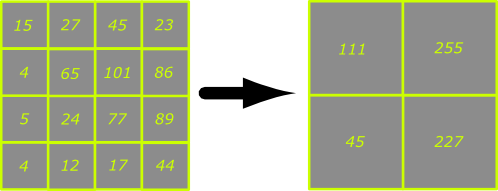...
Binning is a process used to increase the sensitivity of a CCD camera by combining the light-sensitive wells (i.e.pixels) together charge from adjacent pixels to boost the signal-to-noise ratio in the image. If we imagine a hypothetical camera (see below) with a chip consisting of 4 x 4 4x4 pixels and we apply a binning factor of two 2x then 2 x 2 2x2 arrays of adjacent pixels will be combined together to form an array of 'super pixels' that are four times the area of the originals and contain the combined signals charges of the adjacent pixels. This improves the sensitivity signal-to-noise ratio because CCD camera readout noise often obscures low signals. If the readout noise of the hypothetical camera below is 25 grey levels then most of the signals in the image on the left will be indistinguishable from noise. By combining the signal charges from adjacent pixels the readout noise threshold can be exceededis easily exceeded in most of the pixels in the image on the right.
Image acquisition is also faster for binned images because the readout time is shorter and the exposure time is usually shorter too. The drawback of using binning is that the resolution is lower because the specimen is now being sampled (in the example above) by fewer pixels. For example, a specimen imaged with the hypothetical camera above in 2x binning mode would be sampled by four large pixels instead of 16 small ones. The images below broadly illustrate the effect of increasing binning factors on resolution. In the high resolution imaging modes used in fluorescence microscopy you would have to use binning factors higher than 2 to experience the pixelation At high binning factors pronounced pixelation is seen in the images on the right. when all are magnified to the same dimensions.
What does binning mean? (Andor Technologies)
| Anchor | ||||
|---|---|---|---|---|
|
Numerical Aperture (NA)
...

